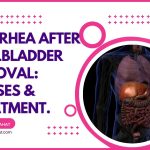Do Gallstones Pass Through Urine or Stool? Doctor Explains
Our content is not intended nor recommended as a substitute for medical advice by your doctor. Use for informational purposes only.
1. Where are gallstones located?
To understand whether gallstones pass through urine or stool, you have to imagine the gallbladder’s location and anatomy of the gallbladder (where gallstones are located).
Gallstones are small-sized (a few millimeters to a few centimeters in diameter). They form inside the gallbladder (a sac-like small organ attached to your liver).
The gallbladder serves as a storage site for bile produced inside the liver. Your gallbladder contracts after meals to empty its contents of bile to the duodenum.
When a small stone is formed inside the gallbladder, it may pass through the bile ducts into the duodenum.
The duodenum is the first part of your small intestine. Contents of the duodenum travel throughout the intestine to reach the colon and finally pass out as a stool.
2. Do gallstones pass through urine or stool?
When a small gallstone escapes from the gallbladder, it passes through the following course:
- First, it passes through the gallbladder into the cystic duct (see the illustration below).
- Then, it reaches the common bile duct, which ends with an opening into the duodenum called the ampulla of Vater.
- When the stone passes through the ampulla of Vater, it falls into the lumen of the duodenum.
- After that, the stone advances through your digestive system (the small intestine, the colon, the rectum, and the anal canal).
- Finally, the gallstone comes out from your body with the stool (not urine).
Conclusion:
Gallstones are formed inside your gallbladder; they may pass through the stool, not urine. Larger stones often cannot escape the gallbladder and often remain inside the gallbladder for years.
3. How do I know I have gallstones?
Three scenarios can occur if you have gallstones:
- No symptoms at all (asymptomatic gallstones).
- Uncomplicated gallstone disease (biliary colics).
- Complicated gallstone disease (acute cholecystitis, biliary obstruction, gallbladder gangrene, perforation, sepsis, etc.).
A. Asymptomatic gallstones:
Gallstones are very common; in the United States, about 6% of men and 9% of women have gallstones (reference).
Unfortunately, most people with gallstones have NO symptoms and may remain asymptomatic throughout life (reference).
In such cases, the gallstones are often discovered incidentally during abdominal imaging.
Also, some may have mild non-specific symptoms (not biliary colics) such as nausea, bloating, and abdominal discomfort after eating.
Who are at higher risk of having gallstones?
- Being a female.
- Being 40 years old or more.
- Being Native American or Hispanic of Mexican origin.
- Obesity.
- Sedentary lifestyle.
- Pregnancy.
- Rapid weight loss.
- People with chronic hemolytic anemia (thalassemia or autoimmune hemolytic anemia).
B. Uncomplicated biliary colics
Gallstones often cause attacks of biliary colics that come and go.
The pain often starts after fatty meals. It is often severe dull constant ache in the upper right quadrant of your abdomen. It may radiate to the back and the right shoulder.
The episode lasts at least 30 minutes and no more than 6 hours. It is often associated with severe nausea and sometimes vomiting.
C. Complicated gallstones.
In a small percentage of people, gallstones may obstruct the gallbladder or the bile ducts, leading to serious complications.
Common complications include:
- Acute cholecystitis: obstruction of the gallbladder opening by the gallstones leads to infection and inflammation of the bile inside the obstructed gallbladder.
- Obstructive jaundice: a small stone may slip into the common bile duct and lead to jaundice and severe biliary colics.
- Gallstone pancreatitis: obstruction of the pancreatic duct by a slipped gallstone leads to symptoms of acute pancreatitis.
- Gallbladder gangrene and perforation.
- Gallbladder sepsis.
The differences between uncomplicated and complicated biliary colics are illustrated in the table below:
| Typical (uncomplicated) gallbladder pain | Complicated gallbladder pain. | |
| 1. Site | Usually, The right upper quadrant of your abdomen. | The same. |
| 2. Spread | – The pain may spread to the back of the right shoulder. – Also, it spreads to the epigastric area. | The same. |
| 3. Character | Constant. Builds up and then disappears gradually. | The same, but more severe and more prolonged. |
| 4. Duration | At least 30 minutes. It may last up to 6 hours. | It can last more than 6 hours. |
| 5. Relation to food | – Triggered by foods (especially fatty food and large meals. – However, it can start spontaneously. | Often persistent. Regardless of eating. |
| 6. Comes and goes? | Yes | No |
| 7. Nausea, vomiting. | Often Present. | Present, but very severe and persistent. |
| 8. Associated symptoms | – Heartburn and chest pain. – Bloating, fullness. – Early satiety. – Epigastric pain. | The same, but more severe. |
| 9. Fever. | Absent. | – Often present. – it is more frequent and severe in gangrenous cholecystitis |
| 10. Jaundice | Absent | Present if there are Bile duct stones. |
| 11. Murphy’s sign (tenderness over the gallbladder area) | Often absent. | – Often present in uncomplicated acute cholecystitis. – It may be absent in gangrenous cholecystitis. |
4. How do I know if I am passing a gallstone?
Passing gallstones often present with a period of severe biliary colics during the passage of the gallstones through the bile ducts.
If the stone passes without getting stuck inside the bile ducts, the biliary colics dramatically disappear after the stone’s passage into the intestine.
After a few hours or days, you may notice the gallstones in your stool.
The most common type is cholesterol gallstones which appear as small-sized, yellowish stones in the toilet.
In this in-depth article, we’ve discussed the exact look of gallstones in the toilet.
5. What is the difference between gallstones and kidney stones?
The following are the main differences between gallstones and kidney stones.
Gallstones | Kidney stones | |
| Site of the stone | Inside the gallbladder or biliary ducts | Inside the kidney, ureter, or the urinary bladder |
| Site of pain | The pain may radiate to the right-back and the right shoulder in the right upper quadrant of the abdomen. | Loin pain (in the flanks), the pain radiates to the back and the groin (with ureteric stones). |
Passing the stone | with the stool | With urine. |
Associated symptoms | Nausea, vomiting, bloating, and bowel issues. | Urinary symptoms: burning micturition, bloody urine, urine urgency, turbid urine, etc. |
- Evidence-based
- Written by a doctor.

Related Posts:
- How Do Blood Clots Look Like In Urine (+ Mimics)
- 5 Main causes of abdominal pain and blood in the urine
- Tea-colored Urine: 5 Main Causes & When to Worry
- Clear Urine with Bubbles: 6 Main Causes & When to Worry
- 10 Takeaway Foods to Eat with Gallstones (& What…
- Can Vomiting Blood Cause Death? Doctor Explains.





